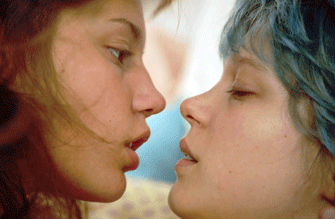
In La Vie d’Adèle, Chapitres 1 et 2 (Blue Is the Warmest Color), director Abdellatif Kechiche lets the drama of a teenage girl’s first love – with another young woman – unfold full-scale, giving her the destiny and physical vibrancy of a heroine in a Zola novel.
In grappling with Adèle’s sensations and appetites, he is gorgeously served by actress Adèle Exarchopoulos. Her body, with its openness and ready responses as she cries, blushes and climaxes during sex scenes, lets all the film’s impulses be newly felt.
At the beginning of the movie, Adèle is a lycée student with loosely tied hair and a baby face. We see her reading Marivaux in the classroom, going to the cinema with a boy she doesn’t really like, eating banal meals with her family. The scenes in which she talks with her friends at the lycée gates or participates in a demonstration are brilliantly, viscerally realized, placing the film in line with Laurent Cantet’s Entre les Murs or Mia Hansen-Løve’s Un Amour de Jeunesse – as well as recent films by Olivier Assayas, Christophe Honoré, François Ozon and others, including Kechiche’s own L’Esquive – as narratives of the very French coming-of-age story in the context of the lycée.
La Vie d’Adèle diverges from those mostly straightforward dramas when Adèle unexpectedly falls in love with Beaux Arts student Emma (Léa Seydoux). In another sexual coming-of-age film, Céline Sciamma’s Naissance des Pieuvres, the love between two girls is left unrequited; the bruising pain of love alone is its subject. La Vie d’Adèle goes further – ironic given that this is the work of a male director – and charts the relationship between the two young women in both its erotic and everyday actuality, its making and its very painful breaking.
Kechiche’s film is an adaptation of Julie Maroh’s bande dessinée Le Bleu Est une Couleur Chaude and is in some ways faithful to it. Perhaps what I loved most was the way the film retained the stylized attention to blue in the graphic novel: the unreal shades of blue in Emma’s hair are picked up in the colors of Adèle’s sheets, the classroom walls, a hydrangea flower, the memorable last dress Adèle wears, and even the shimmering indigo lights of a night-time projection of a film starring Louise Brooks. The color spills through the film, creating many pools of feeling and association. In a first sex scene, a fantasy sequence in which Adèle pleasures herself, imagining that Emma is making love to her, Emma’s blue hair falls over her body in beautiful contact with her skin.
Ever since it was shown in May at the Cannes Film Festival, where Kechiche and his actresses shared the Palme d’Or, La Vie d’Adèle has been notorious for its sex scenes, and some viewers will probably be curious to see how they play out.
In the relationship between Kechiche’s Adèle and Emma, there is sometimes power play, with Emma explicitly teaching Adèle about Sartre, say, and treating her like a child. But in bed, there is almost enforced mutuality. Though the girls’ bodies seem equally moved by each other, the romance and seduction of the Maroh novel are missing.
The film shows some of the urgency and awkwardness of real sex, but I missed a sense of tenderness, endearments or even chatting between the girls. It’s as if we catch scenes from a marathon performance, one set of body shots spliced against another and another. Endurance and ingenuity are part of the sequences, as well as a bodily messiness that appears in numerous eating scenes, and which is eventually, though explicit, oddly unappetizing. Kechiche teases by cutting from the long sex scene to a dinner with Emma’s parents where Adèle, reluctantly, eats raw oysters.
In spite of all the controversy about the sex scenes, the only actual genital shot, of Adèle, comes as she poses naked for Emma in one of several rather labored artist-and-model scenarios.
As the sexual spell begins to break down, the viewer has the feeling of having spent rather too long in close body contact with these very real characters. It’s a relief to come to the later scenes of Adèle post-lycée working as a primary-school teacher. The later sequences of the film are, for me, the most accomplished and emotionally affecting, with Seydoux extraordinarily versatile and convincing as the relationship falls apart.
By the end of the film I had that sense, as in André Téchiné’s J’Embrasse Pas or the Hansen-Løve film mentioned above, of seeing a character, and an actor, growing up on screen. This is what the film does most brilliantly, as Adèle crosses the boundary between girlhood and adulthood. Sometimes this is unsettling: we see how very childlike she is in the early parts, her sleeping face not that different from the faces of the small children she works with later. Her dissolving emotions, tears and runny nose as she lets Emma bully her are painfully childish.
Kechiche has spoken in an interview about editing a longer version of the film and even returning to Adèle, as Franços Truffaut did with his recurring character Antoine Doinel, to film some later episodes of her life. I’ll surely be there to see the next chapters.
Favorite
